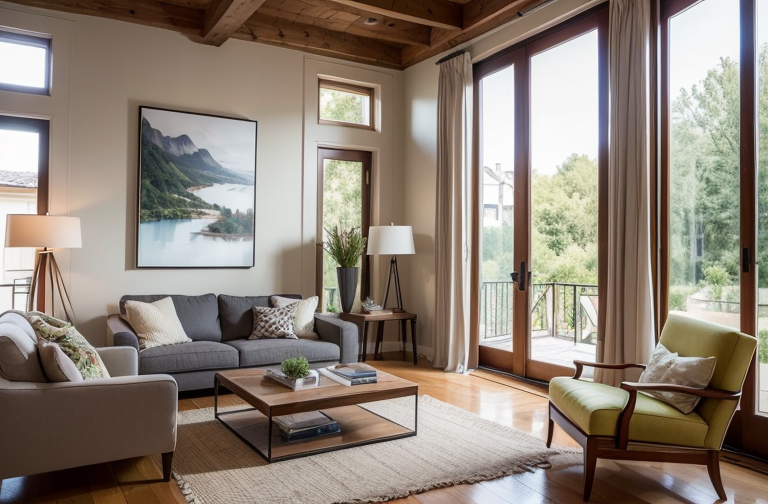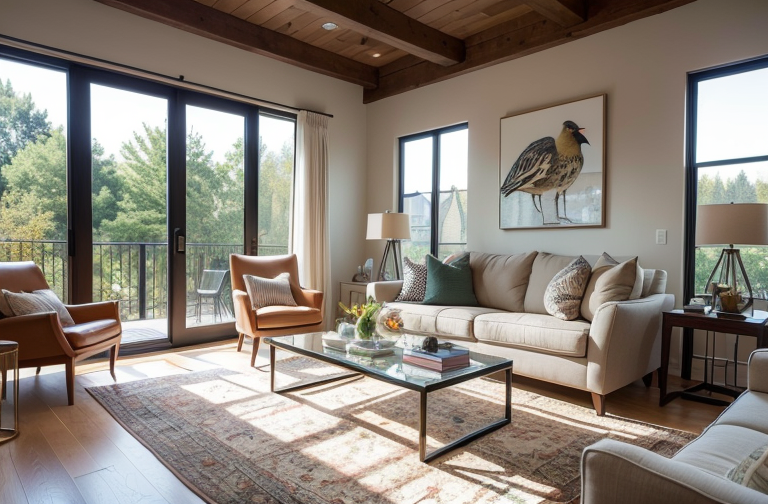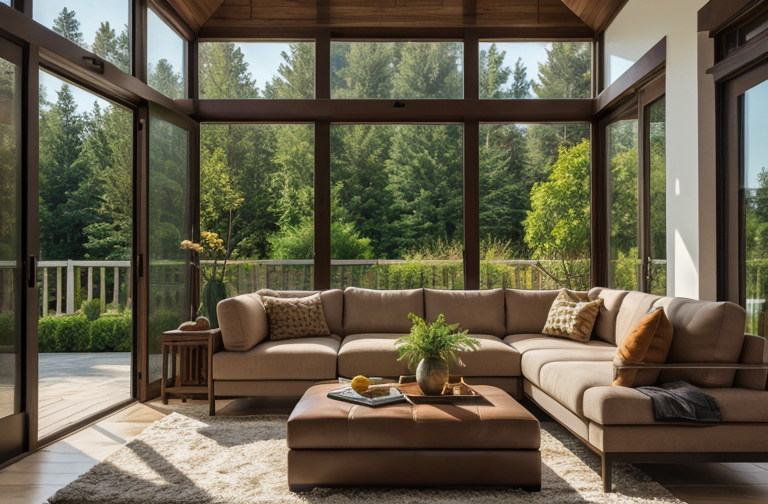Exploring the Rich Influence and Elements of Gothic Style in Architecture and Interior Design

The article discusses the Gothic style and architecture, prevalent from 12th-16th centuries, its influence on other periods, and its modern application in interior designs using vintage accessories and Adobe stock’s Gothic interior collection.
Introduction to Gothic Style
Through this gothic wonderland, let me first bust a myth – gothic design is not all about gloom and doom. Quite the contrary, the style is replete with grandeur and an unmistakable architectural prowess. If one pauses to think about it, house interior designs find a treasure trove in gothic style.
Origin and Development of Gothic Style
It’s a style deeply rooted in tradition, making its first appearance back during the 12th century, a stark evolution from its Romanesque ancestor. Europe reveled in its magnificence from the 12th to the 16th centuries, a time when Gothic style held the scepter of design domination.
Characteristics of Gothic Style
Gothic’s unique patina comes from certain undeniable features ‒ pointed arches making a formidable statement, alongside thin walls supported by proud flying buttresses. Let’s not forget the intricate decorations that glide around the architecture evoking awe inspiring marvels. And the stained glass windows, of course, that paint a picture of radiant grandeur, different slices of colored magic dancing on the castle floors.
Influences and Modern Interpretations of Gothic Style
Gothic style left an indelible imprimatur not just on the time that it reigned but on eras that were to follow. The Victorian era, for example, was heavily influenced by Gothic principles. The style bagged the crown once again during its revival in the 19th century. But what captures our imagination even today is the modern offshoot of this style ‒ the Dark Gothic design that takes the class and finesse up several notches. Its charisma and audacity continue to inspire house interior designs, relentlessly opulent and unapologetically edgy.

Gothic Architecture
As significant developer of interior design, I am reminded of the evolution of Gothic architecture as a pivotal moment in design history. The phase emerged in such a powerful way that it became impossible to ignore. Revisiting the period’s contributions, you observe it evolving in three stages – Early Gothic, High Gothic, and Late Gothic, much like an artist’s creative journey. 🎨
Evolution of Gothic Architecture
Just when the modern trending designs took over the market, it reminded me of the time when I was studying. My professors often compared the contemporary design trends with the old ’Gothic architecture’. There was clearly a massive transformation. Every period had something unique to offer, a fresh perspective weaved into characteristic design elements of that era. Much like when searching house interior designers near me, different professionals each have their unique spins on a similar concept.
Characteristics of Gothic Architecture
The signature characteristic of this style that resonates with me even today is its stylistic expression in buildings and structures. The visually stunning pointed arches, ribbed vaults, and soaring ceilings were not merely about aesthetic appeal, but a structural revolution in itself. The ability to transform spaces, add depth, and keep them functional has been a consistent characteristic of all my work, much like in the Gothic period. 🏛
Signature Gothic Structures
Though it’s difficult to pick one, the first fully coherent Gothic structure, the Saint Denis Abbey in Paris, deserves special mention. Influencing not just the subsequent structures of the era, but inspiring the generations of architectural artists, including the legions of house interior designers, the Abbey has significantly contributed to the design world. It’s an eternal symbol that balances form and function seamlessly in the architectural realm.
My endeavor, alike the Gothic Architects’ approach, has always been to infuse every space with depth and insight, tracing the fine line between sophistication and approachability. After all, aren’t we all striving to create our own sanctuary?

Gothic Interior Design
As an interior designer, I adore the intricate beauty of Gothic design styles. These styles are loaded with deep, intense stories that can add a dramatic tone to your house interior furniture design.
Elements of Gothic Interior Design
At the heart of Gothic decor are dark and brooding elements. The appeal lies in the suggestive undercurrents of shadows and solemnity. In my practice, I frequently incorporate elements like dark drapes, lush wooden furniture, and strikingly painted walls. Don’t forget an occasional hint of the macabre; a subtle skull nestled amidst ornate curios can lend authenticity to the tableau. 🖤
Application of Gothic Style in Interior Spaces
When channeling a Gothic vibe into your living spaces, a singular goal should be: establish an atmosphere that is enchanting yet somber. Such a balancing act often requires a careful choice of colors, steered mainly towards deeper tones. Antique furniture suffused with history and character can augment the rich color palette brilliantly.
Modulation of Gothic Elements in Design
The electrifying aspect of Gothic design lies in mastering the moderation of its elements. I wish to emphasize that this includes the use of black. There is undeniably a strong inclination towards embracing dark spaces in Gothic design. However, the overuse of black can tip the scales towards an overpowering and imbalanced design narrative. Our design principle should always be to revel in this style’s inherent drama without forsaking visual balance. As interior designers, it is a tantalizing challenge we are delighted to undertake.
Achieving a successful Gothic interior design is all about harmonizing these aspects, something I’ve always found enchanting in my design practice!

Gothic Decor Accessories
Diving into the world of house interior finishing designs, I can’t help but mesmerizingly explore the allure of Gothic decor accessories. Heller, they serve such a pivotal role in this style of home decor. They hold the power to intricately weave an ambiance of mystery and drama throughout your living spaces.
Importance of Decor Accessories in Gothic Design
Each Gothic accessory steps into the scene like an actor, setting the stage for an enchanting yet eerie ambiance. These elements are not mere embellishments; instead, they’re responsible for intensifying the entire design’s dark and dramatic vibe. They’re like the salt to my savory culinary masterpiece—without them, the entire aesthetic feels a hint too bland.
Types of Gothic Decor Accessories
In the realm of Gothic decor accessories, variety stirs the cauldron. Elegant vintage lighting fixtures whimsically cast shadows and light, while statues and skulls offer an otherworldly effect. Delving into the mysterious, art painted in dark hues, along with intricate tapestries, bedeck walls, exuding a sense of enigma. Elegant tapestries narrate the tales of an era long past.
Ways to Incorporate Gothic Decor in Interior Design
Incorporating Gothic decor accessories tastefully is somewhat akin to conducting an orchestra; each piece plays a different note, yet, when they’re combined, they evoke an enchanting symphony. Vintage lighting paired with skull accessories can yield an atmosphere teeming with allure. Strategically placed statues or art pieces carry their dramatic flair across the room, while intricately woven tapestries serve as a distinct backdrop to this enthralling spectacle.
In totality, Gothic decor accessories are the unsung heroes of their design narratives. They whisper the tales of darkness and drama that resonate with the essence of this timeless aesthetic. So, be fearless in exploring the mystique of these elements, for the real beauty in design lies within its diversity.
Key Takeaways
Informed by my explorations in the world of design, I have deepened my admiration for the Gothic style and its weighty influence in shaping architectural and house interior designs. It is easy to succumb to the dark allure of Gothic style, a style that continues to shape many design genres, including that of the en vogue ’dark gothic’ design.
Role of Gothic Style in Shaping Architectural and Design Styles
As an interior designer, when I am tasked to design a space, the Gothic style is often my go to for an atmospheric, emotive design. Its significant role, not only informs my work but also the work of many house interior designers near me. The allure of its intricate craftsmanship and romantic grandeur is simply irresistible.
Key Elements of the Gothic Style and Design
The Gothic style is embellished with signature elements such as pointed arches, intricate decorations, large stained glass windows, and unique house interior furniture design. Each element offers a rich, intriguing dialogue with the space it occupies. The play of shadow and light, the dance of color from the stained glass windows, and the complexity of its intricate decorations, all contribute to the formidable yet truthful expression of the Gothic style.
Adapting Gothic Style Into Modern Interiors
Incorporating the Gothic style into modern house interior designs involves balancing old world charm with contemporary sensibilities. Adaptation of this style can lead to stunning house interior finishing designs capable of evoking a sense of grand drama and atmospheric richness. The modern Gothic style breathes a unique, exhilarating, and dramatic atmosphere into interior spaces, making it a captivating choice for those seeking a distinguished aesthetic allure.
As we trace the complexities and depths of the Gothic style, I hope these key insights inspire you to weave a touch of gothic charm into your own space.
- Unlocking the Intricacies of Interior Design: Ranch-Style Homes and the Pursuit of Functionality
- Blending Tradition and Modernity: Exploring the Design of Nipa Hut and Trynagoal Tea House
- Enhancing Dining Experiences through Creative Interior Design and Rebranding in Burger Restaurants
- Mastering Home Renovation: The Crucial Roles of an Interior Designer and Effective Budget Management
- Understanding the Value of Interior Designers: Roles, Benefits, and Selection Process
- Exploring the Richness of Turkish Architecture and Interior Design through Adobe Stock and Pinterest
- Unveiling the Unique Characteristics and Design Elements of Ranch-Style Houses
- Embracing Openness and Personal Touch: The California Ranch House Interior Design Concept
- Embracing Warm Minimalism: The Rise of Brown Tones in Interior Design
- Enhancing Your New Home: Key Elements and Strategies in Interior Design
- Unveiling the Art of Luxury Interior Design: Exploration of Materials, Individual Style and Inspiration from Pinterest
- 13 Easy and Affordable Tips to Spruce Up Your Home Decor
- Exploring the Rich History and Distinctive Features of Tudor Architecture
- Exploring British Home Interiors: From Historical Evolution to Modern Adaptation
- Traversing the World of Interior Design: From Designer Profiles to DIY Ideas and Future-ready Furniture
- Contemporary Home Refinement: Leveraging Exposed Brick Design and Affordable, High-Quality Furnishings
- Exploring the Warmth and Charm of Modern Rustic Interior Design
- Enhancing Duplex and Triplex Interiors: An In-Depth Guide to Style, Lighting, and Effective Use of Space
- Creating Your Dream Bathroom: A Comprehensive Guide to Designs, Functionality, and Material Selection
- Creating Your Personal Spa: Insights into Modern Bathroom Design Trends



